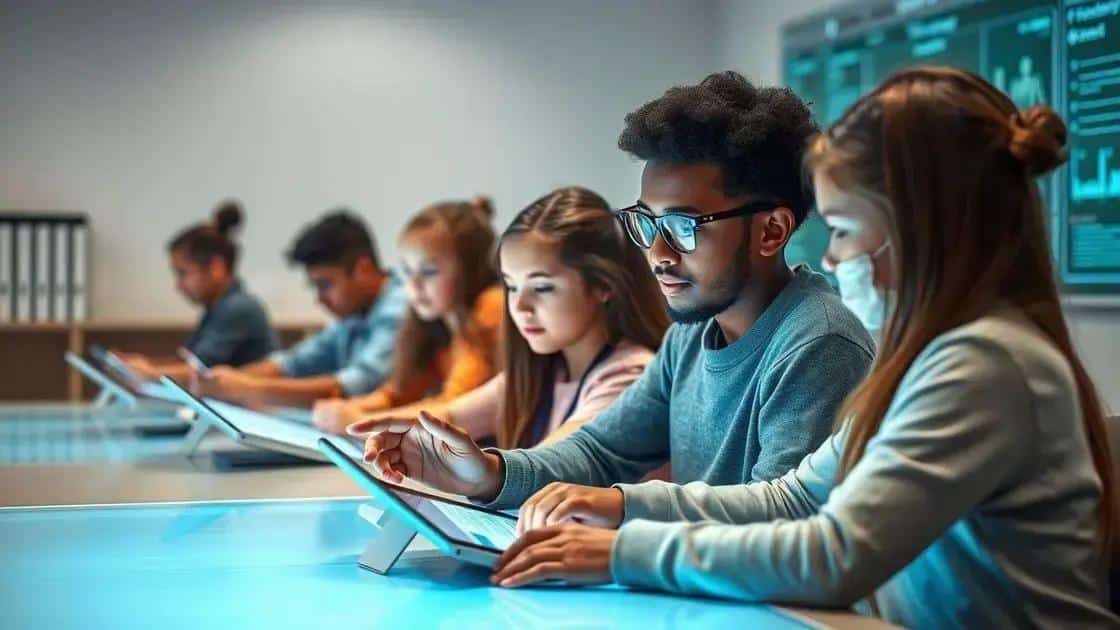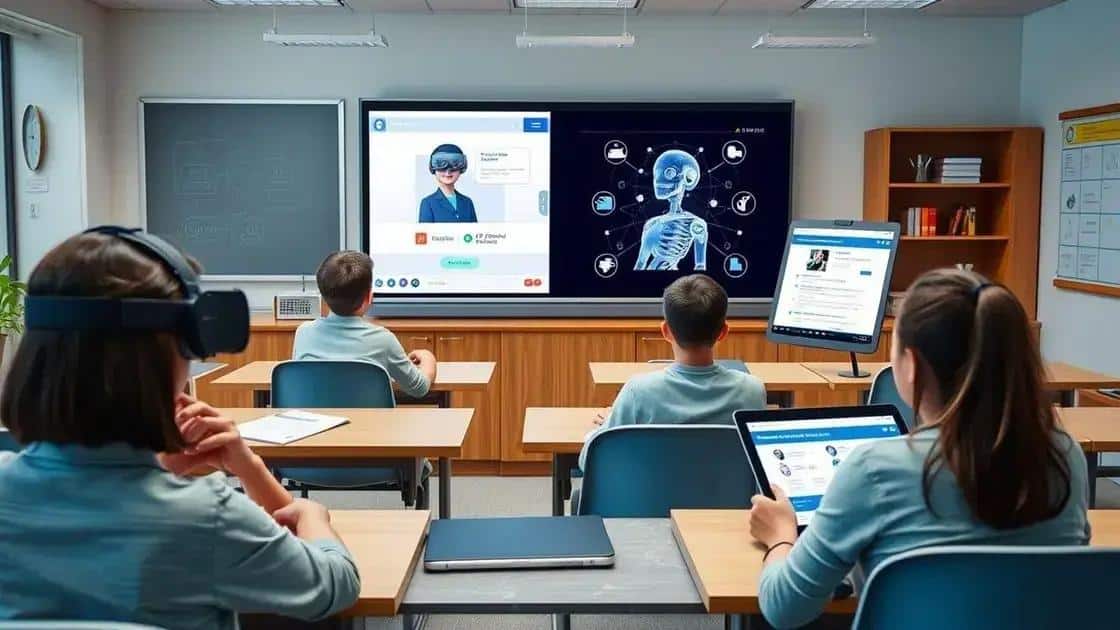Fact ai in the classroom: enhancing learning experiences

AI in the classroom enhances learning by personalizing education, improving collaboration, and preparing students for future careers while also presenting challenges such as the need for proper training and equitable access to technology.
Fact ai in the classroom opens up new possibilities for enhancing student engagement and personalized learning. Have you ever wondered how technology could change the way we teach? In this article, we’ll dive into the world of AI and its impact on education.
What is AI in the classroom?
AI in the classroom refers to the integration of artificial intelligence technologies into educational environments. This innovative approach helps enhance the learning experience for students and teachers alike. By utilizing AI, classrooms can become more interactive and adaptive.
How AI Enhances Learning
One of the most exciting features of AI in education is its ability to tailor learning experiences for individual students. Each learner has unique needs, and AI can analyze performance data to provide personalized resources and activities. For instance, if a student struggles with a specific topic, AI tools can suggest targeted exercises to improve their understanding.
Benefits of AI in Classrooms
- Increased engagement with interactive learning tools.
- Immediate feedback for students, helping them improve quickly.
- Efficient tracking of student progress to inform teaching methods.
AI-powered platforms can also assist teachers by automating administrative tasks, like grading and attendance tracking. This automation frees up valuable time, allowing educators to focus more on teaching and connecting with their students. Imagine a world where teachers spend less time on paperwork and more time inspiring their classrooms!
Moreover, AI can foster collaboration among students. Tools that facilitate group projects or discussions can make learning more social and inclusive, breaking down barriers between students.
Examples of AI Tools in Education
Some popular AI tools currently used in classrooms include personalized learning platforms and virtual teaching assistants. These tools help provide immediate assistance and can cater to students’ various learning paces. Schools that adopt these technologies often see notable improvements in student performance and satisfaction.
In summary, AI in the classroom serves as a powerful ally in modern education. By harnessing the capabilities of AI, schools can create an enriching learning environment that supports both students and teachers.
Benefits of incorporating AI tools
Incorporating AI tools into education brings numerous advantages that can significantly improve the learning environment. These tools help in customizing educational experiences tailored to individual needs, making lessons more effective.
Enhanced Learning Opportunities
One notable benefit is that AI technology makes learning much more engaging. Students can interact with content in ways that were not possible before. For instance, adaptive learning platforms can adjust the curriculum in real-time based on students’ performances.
Efficiency for Educators
Teachers also benefit greatly from using AI tools. By automating repetitive tasks, such as grading and attendance tracking, educators can dedicate more time to teaching. This not only enhances the quality of instruction but also allows teachers to connect better with their students.
- Time-saving features that streamline administrative work.
- Better understanding of student performance through data analysis.
- Support in developing personalized learning plans.
Moreover, AI tools can provide immediate feedback to students. This swift response helps learners understand their strengths and weaknesses, guiding their study habits. Imagine a classroom where each student receives tailored feedback almost instantly!
Accessibility for All Learners
AI can also improve accessibility for students with different learning abilities. Specialized tools can help break down barriers, making education more inclusive. For example, speech recognition software can assist students who have difficulty typing. This ensures that all students have the opportunity to succeed.
Overall, the advantages of incorporating AI tools in classrooms are vast. They create a more dynamic and supportive learning experience that can help all students thrive.
Examples of AI applications in education

There are many exciting AI applications in education that are changing how students learn and teachers teach. These tools can make learning more interactive and personalized, meeting the needs of all learners.
Adaptive Learning Platforms
One of the most popular examples is adaptive learning platforms. These systems adjust the content and pace based on each student’s understanding. For example, if a student struggles with a math concept, the platform can offer extra practice problems tailored to their needs.
- Personalized lessons that adapt to learning speeds.
- Immediate assessments to track progress.
- Engaging activities that resonate with students.
Another great example is the use of chatbots. AI chatbots are available 24/7 to answer questions and provide support. Students can ask about homework help or clarifications on complex topics without waiting for teacher availability. This instant access can boost learning confidence.
Virtual Reality and AI
Virtual reality (VR) and AI are also merging to create immersive learning experiences. Students can explore new worlds or historical events as if they are really there. For instance, a history lesson can turn into a virtual tour of ancient Rome, providing a much richer learning experience.
Moreover, data analytics play a critical role in education. By collecting and analyzing data, schools can identify trends and areas for improvement. Teachers can understand better how their students are performing and adjust their teaching strategies accordingly.
In summary, the breadth of AI applications in education continues to grow, offering unique opportunities to enhance learning. From personalized platforms to VR experiences, these technologies are shaping the future of education.
Challenges educators face with AI
While there are many benefits to using AI in education, educators face several challenges when implementing these technologies in the classroom. Understanding these issues is crucial for a successful transition.
Training and Understanding
One major challenge is the need for comprehensive training. Teachers must understand how to effectively use AI tools to maximize their benefits. Without proper training, they may feel overwhelmed and unsure of how to integrate AI into their lesson plans.
Technical Issues
Technical issues can also pose a significant barrier. This can include everything from software malfunctions to issues with hardware compatibility. Such problems can disrupt the learning process and lead to frustration for both students and teachers.
- Inconsistent access to technology in different classrooms.
- Limited technical support for immediate troubleshooting.
- Challenges with data privacy and security concerns.
In addition, the rapid pace of technology means that educators need to keep updated on the latest AI developments. This constant change can be daunting, making it hard to feel confident in their teaching methods. Furthermore, some educators might resist implementing AI due to fears about losing their jobs to automation.
Equity in Access
There is also the challenge of equity. Not all students have equal access to AI technology at home. This can lead to a digital divide, where those who have access perform better than those who do not. It is vital for schools to address these disparities to ensure fair educational opportunities for everyone.
Despite these challenges, many educators recognize the potential of AI to transform learning. By working together to overcome these obstacles, schools can harness technology’s power to create engaging and effective educational experiences.
Future of AI in teaching and learning
The future of AI in teaching and learning is bright and full of possibilities. As technology continues to advance, we can expect to see significant changes in how education is delivered and experienced by students.
Personalized Learning Experiences
One exciting aspect is the potential for even more personalized learning experiences. With advanced AI analytics, educational tools can adapt in real-time to meet the needs of each student. Imagine if every lesson were tailored just for you, addressing your strengths and weaknesses!
Enhanced Collaboration
AI is also set to enhance collaboration among students and teachers. Collaborative platforms powered by AI will allow students to work together, regardless of location. This serves to build teamwork skills and allows students to learn from one another.
- Access to global classrooms with diverse perspectives.
- Shared projects that encourage communication and cooperation.
- Real-time feedback to enhance collaborative efforts.
Moreover, AI can assist teachers in creating and managing courses. Automated systems will help streamline lesson planning and grading, allowing educators to focus more on student interaction and less on administrative tasks.
Preparing for Future Careers
In addition, AI will prepare students for future careers in a tech-driven world. By integrating AI into the curriculum, schools can equip students with skills they will need in the job market. Learning to work with AI tools and understanding their applications will be crucial as industries evolve.
As we look ahead, the integration of AI in education opens doors for richer, more engaging experiences. This technology promises to reshape classrooms for future generations, making learning more effective and accessible.
FAQ – Frequently Asked Questions about AI in Education
How does AI personalize learning for students?
AI adapts learning materials and experiences to individual student needs, allowing for customized paths that enhance understanding.
What are some examples of AI tools used in classrooms?
Examples include adaptive learning platforms, AI tutoring systems, and virtual assistants that help answer student queries.
What challenges do teachers face when implementing AI?
Teachers often struggle with the need for training, technical issues, and ensuring equitable access to technology for all students.
How does AI prepare students for future careers?
AI equips students with critical skills by integrating technology into the curriculum, preparing them for a tech-driven job market.






